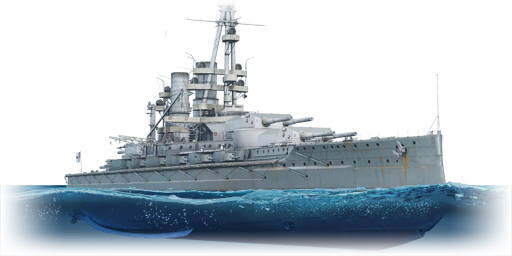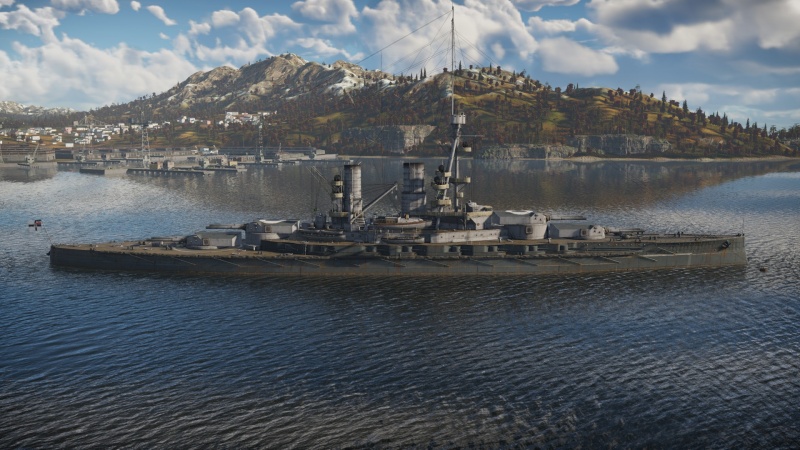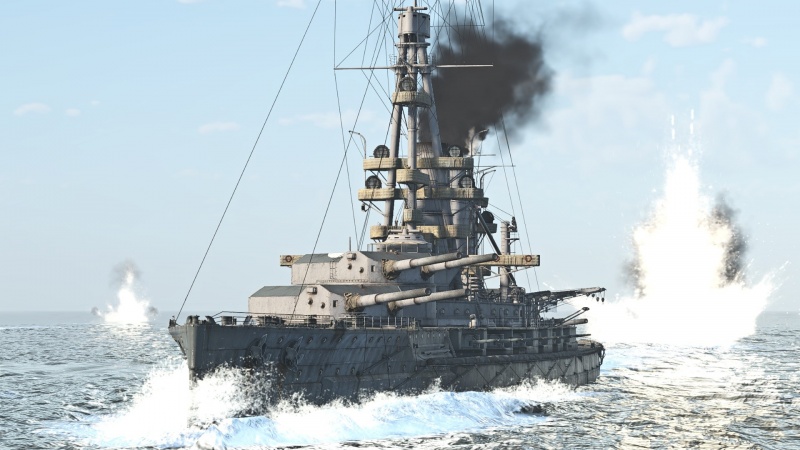SMS Bayern
Contents
Description
The Bayern-class, SMS Bayern, 1916 was the lead ship of the Bayern-class dreadnoughts of the Kaiserliche Marine. She had one sister, Baden, while the other two ordered ships (Sachsen and Württemberg) were cancelled. She was laid down on 22nd December 1913 and commissioned on 15th July 1916. She saw very limited service during her career. Her most notable action was in September 1917 during Operation Albion where she, together with four König- and five Kaiser-class battleships, participated in seizing the Baltic island of Ösel (Saaremaa). During the operation, Bayern struck a mine and had to withdraw to Kiel to undergo repairs. Meanwhile, König and Kronprinz engaged the Russian pre-dreadnought battleship Slava and sunk it. After the German surrender, Bayern was to be handed over to the British. She was scuttled by her crew and sunk at Scapa Flow together with the majority of the German High Seas Fleet.
The Bayern was introduced in Update "Danger Zone". She boasts powerful 38 cm guns paired with an only 26-second reload which is faster than most dreadnoughts with smaller calibre guns. The ship itself is very well-protected, though caution is advised when the armour plates covering the magazines at the waterline are destroyed as this can lead to fatal magazine explosion. The coal bunkers behind the armour belt also further enhance the magazine protection. As the Bayern is a WWI-era ship, she is vulnerable to air attacks as she possesses very limited anti-air weaponry.
General info
Survivability and armour
Bayern has a traditional distributed armor scheme, with armor plating protecting nearly the entirety of the ship. Even the layer which houses the secondary 150 mm cannons in casemate mounts has satisfactory horizontal protection against destroyer and light cruiser fire, being covered in 170 mm of rolled cemented armor. Moreover, critical areas of the Bayern such as turret faces, barbettes, and the bridge are all protected by 350 mm of armor.
The most important part of Bayern's horizontal protection is her main belt, which has a maximal thickness of 350 mm and extends both above and below the waterline. The armored citadel is additionally protected by more than 3 m of coal (effectively above 85 mm of RHA equivalency) and a turtleback of 30 mm. Bayern's side protection is superior to nearly all her tier peers; only her sisters of the Bayern class and the Scharnhorst have equivalent or better side protection, and the belt armor of the Bayern class is the thickest of any 7.0 battleship. That being said, Bayern's side armor can still be penetrated when unangled and/or at close range by other battleships and battlecruisers. Notably, the quite thin turtleback armor is overmatched by any shells exceeding 210 mm in caliber, and therefore does not provide effective protection against any battleship-caliber rounds.
When facing an enemy at an angle, Bayern benefits from her distributed armor scheme, which includes an extended belt of 200 mm of rolled cemented armor, which tapers to 170 mm at the stern and connects to a 30 mm icebreaker at the bow. This complete longitudinal protection ensures that Bayern is fully protected against cruiser fire across the waterline of her entire hull, and her extended belt armor and icebreaker can prematurely fuze incoming battleship-caliber AP rounds when at an angle. Additionally, Bayern's transverse bulkhead armor is competent, with a maximal thickness of 300 mm around the centerline, though the transverse bulkhead armor decreases to a minimum of 170 mm as you move away from the centerline of the ship. In addition to the primary transverse bulkhead armor, there is an additional transverse armor plate of 140 mm at the point where the extended bow belt armor meets the icebreaker that further protects the Bayern from bow-on fire. The horizontal protection of the stern is also capped off by a 170 mm armor plate, though incoming fire directly hitting the stern from the rear is more unusual than bow-on fire.
The vertical protection of the Bayern is significantly worse than her horizontal protection, as her design was created in an era before attack aircraft or plunging fire was a possible military threat. Her deck armor is only 40 mm of RHA around her smokestacks and superstructure, and the rest of her deck armor is even worse, at only 30 mm. The roof of the armored citadel similarly is only protected by 30 mm. The lack of vertical protection means Bayern cannot resist any aerial attack, particularly if bombs are dropped. Even explosions from high-powered HE rounds, such as those found on British battleships like the Marlborough, can hit the Bayern's superstructure and splash downward, damaging internal components while bypassing the side armor that would otherwise stop those HE shells.
In contrast with her side protection, Bayern's main turret protection is unimpressive compared to peer battleships. The turret face armor of 350 mm, while effective against cruiser-caliber fire, is definitively penetrated by battleships at ranges less than 10 km. This means that it's quite common for turrets to get disabled when combating other battleships unless a long range is maintained. The sides and backs of her turrets are even less protected at 250 mm and 290 mm respectively, though this armor remains solid against light cruisers until they are at point-blank range, and against more powerful heavy cruisers Bayern's side turret armor is effective until 5 km.
A similar pitfall of Bayern's protection is her internal component locations; her 380 mm shell magazines end exactly at the waterline. This unfortunate placement, in addition to the massive size of her magazines, makes ammunition excessively susceptible to detonation by any penetrating shells. Bayern's boilers and transmissions are also located at the waterline and are therefore also very susceptible to damage. Bayern's propulsion system does have a theoretical merit in that it has three propellers and therefore increased redundancy, though in battle it's unlikely that penetrating hits will only damage one of the propeller systems without damaging any adjacent transmissions or ammunition magazines.
Compounding on the magazine issue, Bayern lacks dedicated torpedo protection, and is therefore exceedingly susceptible to any underwater damage. While there is minor protection of underwater portions by more than a meter of coal and 50 mm plating, the enormous size of the magazines and the consequent proximity to the ship's sides means that torpedo hits near her ammunition stowages will likely cause catastrophic ammunition detonation. The Japanese Type 93 Model 3 torpedoes are a particular danger for the Bayern, given the torpedoes' great range and their nearly one ton of explosive filler.
Mobility
Bayern's mobility is generally unimpressive, as is typical for (super-)dreadnoughts. Bayern's top speed of 41 km/h (48 km/h in arcade) isn't great, though it does compare at least somewhat favorably to other nations' battleships; the Bayern is slightly faster than the American Standard-type battleships, the Russian dreadnoughts (and their Soviet modernizations), British battleships, and French dreadnoughts, though in all these cases the speed difference is near 1 km/h. To complete the national comparison, Japanese super-dreadnoughts and Italian battleships are faster than Bayern.
Similarly to her moderate top speed, Bayern has a poor turning ability, reducing her ability to dodge incoming fire or torpedoes.
| Mobility Characteristics | |||
|---|---|---|---|
| Game Mode | Upgrade Status | Maximum Speed (km/h) | |
| Forward | Reverse | ||
| AB | |||
| Upgraded | 48 | 27 | |
| RB/SB | |||
| Upgraded | 41 | 23 | |
Modifications and economy
Armament
Primary armament
Provide information about the characteristics of the primary armament. Evaluate their efficacy in battle based on their reload speed, ballistics and the capacity of their shells. Add a link to the main article about the weapon: {{main|Weapon name (calibre)}}. Broadly describe the ammunition available for the primary armament, and provide recommendations on how to use it and which ammunition to choose.
| Penetration statistics | |||||||
|---|---|---|---|---|---|---|---|
| Ammunition | Type of warhead |
Penetration @ 0° Angle of Attack (mm) | |||||
| 1,000 m | 2,500 m | 5,000 m | 7,500 m | 10,000 m | 15,000 m | ||
| Spr.gr. L/4,1 Bdz. | SAP | 458 | 402 | 325 | 266 | 221 | 170 |
| Psgr. L/3,5 APCBC | APCBC | 595 | 553 | 492 | 440 | 396 | 332 |
| Shell details | ||||||||||||
|---|---|---|---|---|---|---|---|---|---|---|---|---|
| Ammunition | Type of warhead |
Velocity (m/s) |
Projectile mass (kg) |
Fuse delay (s) |
Fuse sensitivity (mm) |
Explosive mass (TNT equivalent) (kg) |
Ricochet | |||||
| 0% | 50% | 100% | ||||||||||
| Spr.gr. L/4,1 Bdz. | SAP | 800 | 750 | 0.025 | 26 | 67.1 | 47° | 60° | 65° | |||
| Psgr. L/3,5 APCBC | APCBC | 800 | 750 | 0.025 | 26 | 25 | 48° | 63° | 71° | |||
Secondary armament
Some ships are fitted with weapons of various calibres. Secondary armaments are defined as weapons chosen with the control Select secondary weapon. Evaluate the secondary armaments and give advice on how to use them. Describe the ammunition available for the secondary armament. Provide recommendations on how to use them and which ammunition to choose. Remember that any anti-air armament, even heavy calibre weapons, belong in the next section. If there is no secondary armament, remove this section.
| Penetration statistics | |||||||
|---|---|---|---|---|---|---|---|
| Ammunition | Type of warhead |
Penetration @ 0° Angle of Attack (mm) | |||||
| 1,000 m | 2,500 m | 5,000 m | 7,500 m | 10,000 m | 15,000 m | ||
| Sprgr. L/4.1 Kz | HE | 21 | 21 | 21 | 21 | 21 | 21 |
| Sprgr. L/4.1 Bdz | SAPBC | 95 | 80 | 61 | 47 | 37 | 28 |
| Psgr. L/3.7 | APCBC | 238 | 201 | 153 | 117 | 93 | 71 |
| Shell details | ||||||||||||
|---|---|---|---|---|---|---|---|---|---|---|---|---|
| Ammunition | Type of warhead |
Velocity (m/s) |
Projectile mass (kg) |
Fuse delay (s) |
Fuse sensitivity (mm) |
Explosive mass (TNT equivalent) (g) |
Ricochet | |||||
| 0% | 50% | 100% | ||||||||||
| Sprgr. L/4.1 Kz | HE | 835 | 45.3 | 0 | 0.1 | 1,600 | 79° | 80° | 81° | |||
| Sprgr. L/4.1 Bdz | SAPBC | 835 | 45.3 | 0.01 | 7 | 1,050 | 48° | 63° | 71° | |||
| Psgr. L/3.7 | APCBC | 835 | 45.3 | 0.015 | 7 | 990 | 48° | 63° | 71° | |||
Anti-aircraft armament
Like many other WWI-era battleships the anti-aircraft suite on the Bayern is very lacking. With only 2 x 88 mm cannons, one on the right and left side located near the centre of the ship, the Bayern will struggle to defend itself from enemy aircraft. The reload on these weapons in somewhat decent allowing for a semi-sustained rate of fire. If a shot lands on an enemy aircraft, the 88 mm shell will almost always take it out of the sky.
With such a small amount of anti-aircraft weapons, their effectiveness against enemy ships will be negligible. It is not recommended to repair these while fighting other ships if they are damaged due to their minimal firepower.
Overall, the anti-aircraft armament on the Bayern is mediocre and matches the poor effectiveness of most other WWI-era battleships.
Additional armament
Describe the available additional armaments of the ship: depth charges, mines, torpedoes. Talk about their positions, available ammunition and launch features such as dead zones of torpedoes. If there is no additional armament, remove this section.
Usage in battles
Describe the technique of using this ship, the characteristics of her use in a team and tips on strategy. Abstain from writing an entire guide – don't try to provide a single point of view, but give the reader food for thought. Talk about the most dangerous opponents for this vehicle and provide recommendations on fighting them. If necessary, note the specifics of playing with this vehicle in various modes (AB, RB, SB).
Pros and cons
Pros:
- Strong belt armour
- Manoeuvrable: good acceleration and deceleration
Cons:
- Extremely weak deck armour, only two layers of 30 mm armour plate
- Mediocre main gun: SAP loses penetration over distance drastically, and APC has less than 600 mm penetration
- Main gun ammunition is stored together with auxiliary gun ammunition; they are prone to fire hazard and chain detonation
- Crew compartments and boilers/transmission are not separated by internal structural armour. Fire will spread and cause severe damage
History
SMS Bayern was the lead ship of the Bayern-class dreadnoughts of the Kaiserliche Marine. She had one sister, Baden, while the other two ordered ships were cancelled. She was laid down on 22nd December 1913 and commissioned on 15th July 1916. She saw very limited service during her career. Her most notable action was in September 1917 during Operation Albion where she, together with four König- and five Kaiser-class battleships, participated in seizing the Baltic island of Ösel (Saaremaa). During the operation, Bayern struck a mine and had to withdraw to Kiel to undergo repairs. Meanwhile, König and Kronprinz engaged the Russian pre-dreadnought battleship Slava and sunk it. After the German surrender, Bayern was to be handed over to the British. She was scuttled by her crew and sunk at Scapa Flow together with the majority of the German High Seas Fleet.
Media
- Skins
See also
Links to articles on the War Thunder Wiki that you think will be useful for the reader, for example:
- reference to the series of the ship;
- links to approximate analogues of other nations and research trees.
External links
| Howaldtswerke-Deutsche Werft | |
|---|---|
| Minelayer | |
| R-1-class | Drache(*)** |
| Battleships | |
| Helgoland-class | SMS Helgoland* |
| Bayern-class | SMS Bayern* |
| *Previously Howaldtswerke, Kiel **Previously Deutsche Werft, Hamburg (*)KB Zmaj before it was captured by Nazi Germany | |
| Germany battleships | |
|---|---|
| Nassau-class | SMS Nassau · SMS Westfalen |
| Helgoland-class | SMS Helgoland · SMS Ostfriesland |
| Kaiser-class | SMS Kaiser |
| Bayern-class | SMS Bayern · SMS Baden · SMS Sachsen |






